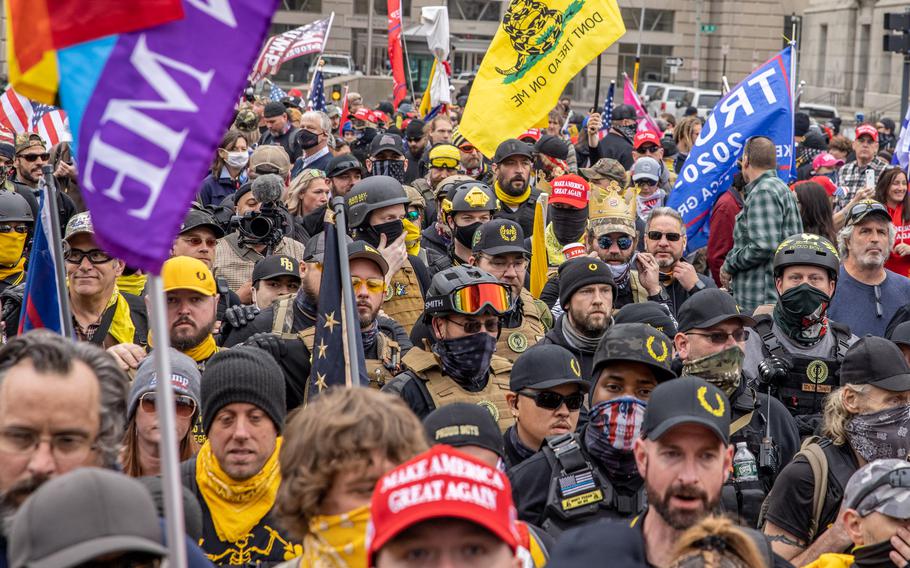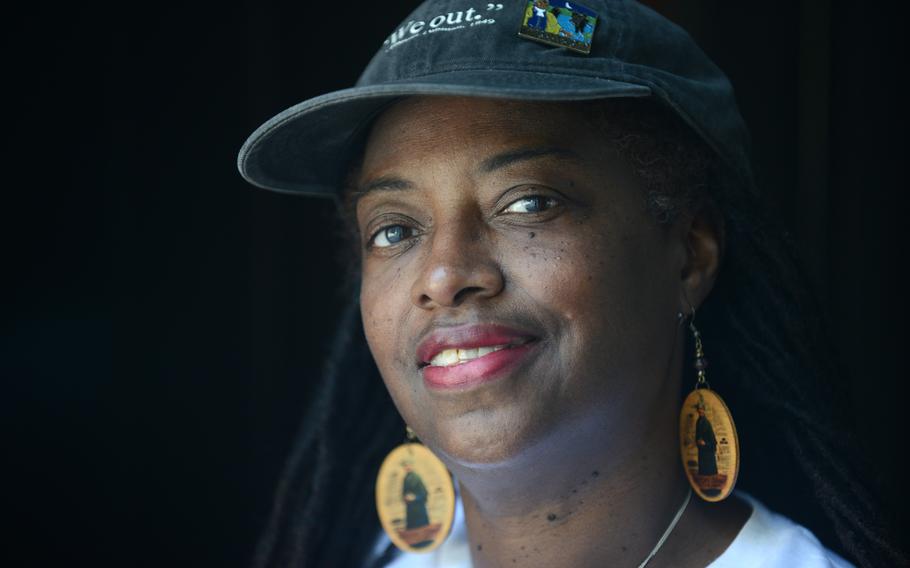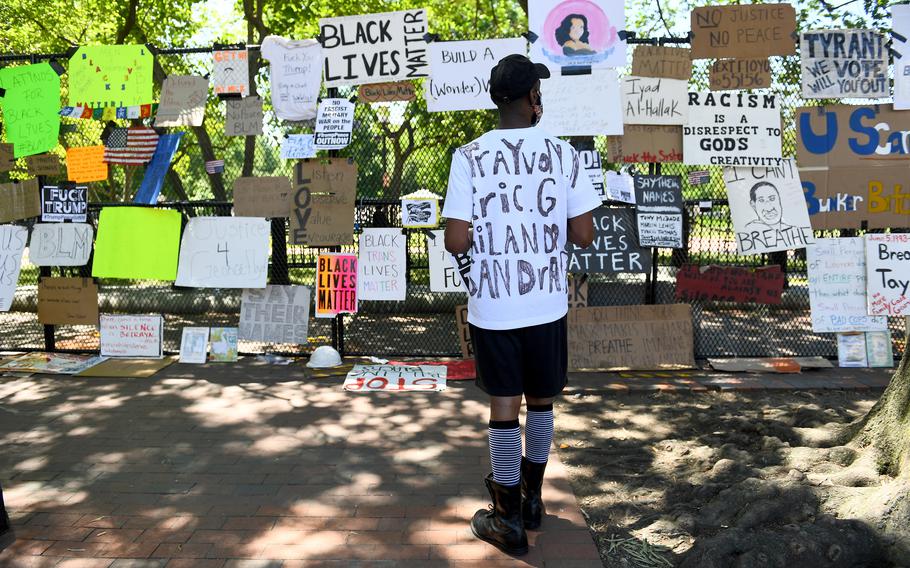U.S.
They confronted Proud Boys but don’t celebrate the prison sentences
The Washington Post September 10, 2023
These demonstrators marched in the streets for months, calling for justice for George Floyd and an end to racism and police brutality. Then in late 2020, the Proud Boys arrived, roaming downtown D.C. looking to fight.
The mostly white men dressed in body armor and helmets, carrying bear spray, brass knuckles, guns and other weapons. Arriving from around the country, they wore black and yellow and logos proudly declaring their affiliation with a far-right group with a history of violence.
Weeks later, on Jan. 6, 2021, members of the Proud Boys were a driving force in the rioting at the U.S. Capitol. Dozens of people who prosecutors say are affiliated with the group have been found guilty of crimes in connection with the attack. Four leaders of the Proud Boys — Henry “Enrique” Tarrio, Ethan Nordean, Joe Biggs and Zachary Rehl — have now been convicted of engaging in seditious conspiracy to keep Donald Trump in power by force and sentenced to between 15 and 22 years in prison.

Members of the Proud Boys attend a pro-Trump rally in Washington on Dec. 12, 2020. (Evelyn Hockstein for The Washington Post)
All four men marched on D.C. streets in the weeks before the insurrection. Only Tarrio was convicted of a crime related to those 2020 protests, for burning a Black Lives Matter banner ripped from the facade of a historic Black church. But federal prosecutors argued that having successfully “ravaged the streets of D.C. with violence” in the fall emboldened the Proud Boys to use force on Jan. 6.
Several demonstrators who encountered Proud Boys members in the weeks before the attack on the Capitol said they are still contending with the impact. Some who oppose incarceration said they are conflicted about the lengths of the sentences the Proud Boys leaders received. Here are their stories from the street brawls in the months leading up to the insurrection.
Afeni Evans
She realized they were surrounded.
Five men in black and yellow clothing walked toward her group of eight, yelling at one of them. Soon, Evans saw at least two dozen more men approaching.
Evans and her fellow racial justice protesters had read the discussions in right-wing chatrooms ahead of pro-Trump rallies in the District: People were claiming violence was patriotic, invoking the American Revolution and calling for a civil war. She saw them openly share how they armed themselves with bear spray and weapons.
On this December night in 2020, after a long day of counterprotesting Trump supporters and protecting the Black Lives Matter Memorial Fence outside the White House, Evans, then 23 years old, was just trying to get home. She had only a helmet for protection. Evans, a 5-1 Black woman, feared for her life.

Afeni Evans at Black Lives Matter Plaza in D.C. in 2021. MUST CREDIT: Washington Post photo by Marvin Joseph ()
The men began to hit her in the back of her helmet, she said. Her ears were ringing. They shoved her. She focused on staying close to the friend by her side. Another racial justice protester was punched in the face. She doesn’t remember what exactly the men said but recalls a lot of yelling.
When police arrived at 11:49 p.m. on the 1500 block of K Street NW, they saw a street brawl and attempted to separate the two sides, according to court records. Records show authorities alleged Evans “swung her right fist” at one of the other men, who was ultimately arrested, and tried to pull officers off another man as police tried to arrest him. Evans said she did not assault anyone.
Police also arrested Evans, and prosecutors charged her with simple assault and resisting arrest. Court records show charges against Evans were dropped after she completed a diversion program.
“We were really genuinely scared that we were going to lose our lives that day,” said Evans, who lives in the D.C. region. “We spent the night in jail for being attacked — for basically being jumped by these people and defending ourselves against them.”
Her feelings about the Proud Boys leaders’ sentencings are complicated.
Evans is an abolitionist — someone who believes prisons should not exist. For that reason, it’s tough for her to be happy about anyone being incarcerated, even a Proud Boy leader like Tarrio.
“I think about the violence and brutality people are exposed to when they are incarcerated, especially for that long,” she said of Tarrio’s 22-year sentence. “Not to say he shouldn’t be held accountable, because he should be. They all should. But incarceration is brutal.”
She thinks true justice would include Americans being honest about the country’s history, atoning for it and working toward eradicating white supremacy. “I don’t think the ideology that fuels them is going away anytime soon,” she said.
Kevin Cramer Jr. leads a chant during a protest march near the Supreme Court in June 2022. (Amanda Andrade-Rhoades for The Washington Post)
Kevin Cramer Jr.
Every time the Proud Boys came to the District, local organizer Kevin Cramer Jr. said, they came looking for a fight.
One night in late 2020, they surrounded hundreds of racial justice protesters, including Cramer, at Black Lives Matter Plaza with D.C. police standing between the groups.
Although Cramer, who is Black, was never physically assaulted by the Proud Boys, he was terrified by stories he heard from friends and fellow protesters. Violence was so commonplace, he said, that protesters pooled money to pay for hotel rooms near Black Lives Matter Plaza so people would not have to walk home alone at night.
Seeing the Proud Boys in D.C. solidified Cramer’s determination to fight for racial justice and Black liberation. He co-founded the Palm Collective, a group focused on ending systemic racism, and continues to organize in the D.C. region.
“These people didn’t care about anybody’s life. ... They came here to attack people,” Cramer, a 28-year-old Arlington resident, said of the Proud Boys. “It was just, you know, wickedness at an all-time high.”
He blames D.C. police for allowing these men to menace the city, especially during the coronavirus pandemic.
“Who allows them to come here three times?” Cramer said. “It’s the police that were working with them, that were allowing them to roam and take over our streets.”
In response to these allegations, Paris Lewbel, a D.C. police spokesman, said in a statement that in “a challenging and volatile environment, where various groups clashed” police “went to great lengths to maintain peace and order.” Several officers were injured when responding to Proud Boys-related events in 2020, Lewbel said.
D.C. police lieutenant Shane Lamond, a 24-year veteran of the force who was then the department’s head of intelligence, was arrested in May on allegations that he leaked information to Tarrio. Lamond pleaded not guilty; his attorney has said Lamond engaged with Tarrio only as part of his work monitoring extremist groups.
About 140 Capitol Police and D.C. officers were injured on Jan. 6, 2021, and authorities have charged about 400 people with assaulting those officers.
Cramer said the Proud Boys leaders’ sentences do not match the severity of their crimes. He believes they would have been more harshly punished if the rioters and their leaders were all people of color.
“It didn’t send a message that you threatened the freedom of our country,” Cramer said of the sentences. “If people were on the Capitol with hijabs, America would have a field day.”
Although Cramer has no faith in the criminal justice system, he concedes it is the only tool currently available to hold the Proud Boys accountable. To him, locking them away isn’t necessarily justice, but it is a move toward equity: “What’s happening to them is the same thing that happens to everybody else in America.”

Nee Nee Taylor, co-founder and executive director of Harriet’s Wildest Dreams, an abolitionist group in the D.C. region. (Astrid Riecken for The Washington Post)
Nee Nee Taylor
Nee Nee Taylor remembers talking with Tarrio at the Black Lives Matter Memorial Fence in late 2020 about his leadership position in the Proud Boys and his identity as an Afro-Cuban man.
Taylor, a longtime D.C. organizer, pointed out the photos dotting the fence of those killed by police, a majority of whom were Black men. He wasn’t moved, she said.
“He basically said, like, the fence was a joke and encouraged people to tear up the fence,” Taylor said. She then recalled him arguing that the Proud Boys could not be a racist organization because he is Black.
When the Proud Boys marched in November and December of 2020, Taylor said, they threw plastic water bottles at crowds of racial justice protesters, including her, and yelled racial slurs. She feared for the young activists in the movement for Black lives, who, she said, were targeted with bear spray. She said she sought to deter hotels from allowing Proud Boys to stay on their premises in a “don’t host hate” campaign. On Jan. 6, 2021, she said, she urged Black people to stay home.
After the insurrection, Taylor helped found Harriet’s Wildest Dreams, a Black-led mutual aid and community defense organization. She views Tarrio’s sentencing — the longest sentence yet — as an example of disparities in the criminal justice system. If Tarrio, who was not at the Capitol on Jan. 6, 2021, had been a white man, Taylor believes his sentence would be more in line with those of others convicted of similar crimes.
Still, Taylor said justice is not locking someone in a cell. Instead, she said, it is reparations for the people who were physically and emotionally harmed and a condition that these men are never allowed back into the District.
Taylor said she increased her visits to therapy with sessions focused on processing what happened when the Proud Boys came to the District.
“They didn’t see us as Americans. They didn’t care that Black bodies, lives, were being taken,” Taylor said. “They didn’t understand that we don’t deserve to die.”
Adam Lawrence
Adam Lawrence, a 38-year-old white anti-fascist activist from Frederick, Md., said he came to the District in fall 2020 to counterprotest the pro-Trump rally and show solidarity with D.C. residents. In November, his group left before dark and only heard about the violence that happened at night. In December, they encountered it much earlier in the day. Just as he was arriving in the city with a few fellow activists, he said they were ambushed; video shows a man punched Lawrence in the back of the head after muttering “f---ing Jews.”
A scuffle ensued in which Lawrence was pinned to the ground, banging his knee on the sidewalk. Video of the encounter shows the attackers were part of a group wearing Proud Boys colors.
Police arrived quickly and separated the two groups. But Lawrence said he was arrested and sent to jail for 48 hours before being released without charges. A police report listed one of the people Lawrence claims attacked him as the victim — a man Lawrence learned had been arrested in a racially motivated machete attack five years earlier. Lawrence said he filed a complaint with D.C. police, and when he met with them he shared video of the attack, but the men who assaulted him never faced charges. He said that he also warned police the Proud Boys and others were “flagrantly broadcasting their intentions” for Jan. 6 but that he got no reply.
The D.C. police spokesman said in a statement that the department could not find information related to Lawrence’s arrest or citizen complaint. A police report Lawrence provided to The Post does not include his name, but lists the other man as the victim of politically motivated violence.
Lawrence had intermittent pain in his knee for a year and struggled with acute stress from the assault. On the day of the Capitol riot, he stayed home from work, “stuck to YouTube,” watching the attack unfold.
“The folks who are being held accountable are getting severe sentences, and that is encouraging,” he said. “I’m not a fan of the prison-industrial complex. But if we’re going to put anybody in prison, it should be people who are trying to undermine democracy.”
But he worries the same laws will be used to punish activists on the left “just for being in the area of a protest.” About a dozen states passed laws criminalizing various forms of protests after the summer of 2020, according to the International Center for Not-for-Profit Law. Lawrence added that “the Proud Boys have not gone away by any stretch,” noting that the group has been implicated in violence around LGBTQ+ events and school board meetings in the past two years.
“There will be plenty of replacements for people like Enrique Tarrio,” he said.
April Goggans
As the Proud Boys came from two different directions on Nov. 14, 2020, April Goggans said, D.C. police accidentally shepherded her and other racial justice protesters straight into the right-wing extremists. Goggans, an organizer with Black Lives Matter DC, said she was getting stepped on and tried to lock arms with protesters beside her for stability. Men were chanting “USA!” Someone sprayed mace toward her.
Goggans, a 44-year-old resident of the District’s Anacostia neighborhood, recognized the Proud Boys by their colors and logos.
The following month, as Proud Boys, Oath Keepers and other extremist white men with weapons poured into Black Lives Matter Plaza, Goggans took shelter in a room activists booked at a nearby hotel for safety. As a Black woman, these experiences were making her feel as if she were back home in rural Colorado, “times 30.”
She knew of only one other Black family in her hometown. When, as a middle-schooler, she went to the county fair with her family to show their animals — llamas, sheep, hogs and rabbits — white men wearing camouflage net hats and cowboy boots called them the n-word.
She moved to the District in 2006 to be in a city with more Black people — so she could just exist without feeling under attack.
Upon hearing of the leaders’ sentencings, Goggans said that locking someone up is punishment but not justice.
More importantly, she said, this country needs to address the root cause of the violence that took place in late 2020 and on Jan. 6, 2021.
“Just locking someone up, hiding that person until they can come out,” Goggans said, “it doesn’t fix anything.”
Tom Jackman and Spencer S. Hsu contributed to this report.

Latif Schofield looks at the protest signs and artwork on the fence surrounding the White House on June 7, 2020. (Katherine Frey/The Washington Post)